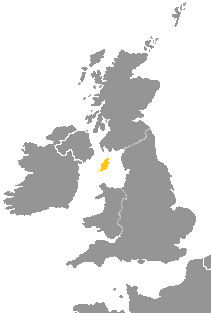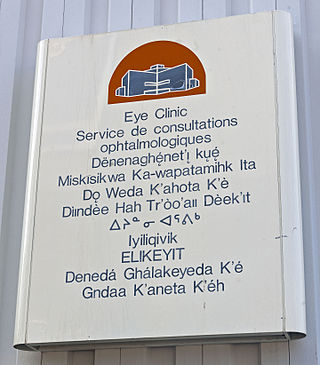British English is the set of varieties of the English language native to the island of Great Britain. More narrowly, it can refer specifically to the English language in England, or, more broadly, to the collective dialects of English throughout the British Isles taken as a single umbrella variety, for instance additionally incorporating Scottish English, Welsh English, and Ulster English. Tom McArthur in the Oxford Guide to World English acknowledges that British English shares "all the ambiguities and tensions [with] the word 'British' and as a result can be used and interpreted in two ways, more broadly or more narrowly, within a range of blurring and ambiguity".
Canadian English encompasses the varieties of English used in Canada. According to the 2016 census, English was the first language of 19.4 million Canadians or 58.1% of the total population; the remainder spoke French (20.8%) or other languages (21.1%). In the Canadian province of Quebec, only 7.5% of the population are anglophone, as most of Quebec's residents are native speakers of Quebec French.
H, or h, is the eighth letter of the Latin alphabet, used in the modern English alphabet, including the alphabets of other western European languages and others worldwide. Its name in English is aitch, or regionally haitch.

Hiberno-English or Irish English (IrE), also formerly sometimes called Anglo-Irish, is the set of English dialects native to the island of Ireland.

Manx, also known as Manx Gaelic, is a Gaelic language of the insular Celtic branch of the Celtic language family, itself a branch of the Indo-European language family. Manx is the historical language of the Manx people.
Modern English (ME), sometimes called New English (NE) as opposed to Middle and Old English, is the form of the English language that has been spoken since the end of the Great Vowel Shift in England, which was completed by the end of the 17th century.
H-dropping or aitch-dropping is the deletion of the voiceless glottal fricative or "H-sound",. The phenomenon is common in many dialects of English, and is also found in certain other languages, either as a purely historical development or as a contemporary difference between dialects. Although common in most regions of England and in some other English-speaking countries, and linguistically speaking a neutral evolution in languages, H-dropping is often stigmatized as a sign of careless or uneducated speech.

Fijian is an Austronesian language of the Malayo-Polynesian family spoken by some 350,000–450,000 ethnic Fijians as a native language. The 2013 Constitution established Fijian as an official language of Fiji, along with English and Fiji Hindi and there is discussion about establishing it as the "national language". Fijian is a VOS language.

West Country English is a group of English language varieties and accents used by much of the native population of the West Country, an area found in the southwest of England.

Bermudian English is a regional dialect of English found in Bermuda, a British overseas territory in the North Atlantic. Standard English is used in professional settings and in writing, while vernacular Bermudian English is spoken on more casual occasions. The Bermudian dialect began to develop following settlement in the early 17th century and retains traits of Elizabethan English.

Inuktitut, also known as Eastern Canadian Inuktitut, is one of the principal Inuit languages of Canada. It is spoken in all areas north of the North American tree line, including parts of the provinces of Newfoundland and Labrador, Quebec, to some extent in northeastern Manitoba as well as the Northwest Territories and Nunavut. It is one of the aboriginal languages written with Canadian Aboriginal syllabics.

A multitude of languages have always been spoken in Canada. Prior to Confederation, the territories that would become Canada were home to over 70 distinct languages across 12 or so language families. Today, a majority of those indigenous languages are still spoken; however, most are endangered and only about 0.6% of the Canadian population report an Indigenous language as their mother tongue. Since the establishment of the Canadian state, English and French have been the co-official languages and are, by far, the most-spoken languages in the country.
Irish verb forms are constructed either synthetically or analytically.

Tuscan is a set of Italo-Dalmatian varieties of Romance spoken in Tuscany, Corsica, and Sardinia.
In English, the digraph ⟨th⟩ represents in most cases either one or the other of two phonemes: the voiced dental fricative and the voiceless dental fricative. Occasionally, it stands for or the cluster. In compound words, ⟨th⟩ may be a consonant sequence rather than a digraph.

Ulster English, also called Northern Hiberno-English or Northern Irish English, is the variety of English spoken in most of the Irish province of Ulster and throughout Northern Ireland. The dialect has been influenced by the Ulster Irish and Scots languages, the latter of which was brought over by Scottish settlers during the Plantation of Ulster and subsequent settlements throughout the 17th and 18th centuries.

Atlantic Canadian English is a class of Canadian English dialects spoken in Atlantic Canada that is notably distinct from Standard Canadian English. It is composed of Maritime English and Newfoundland English. It was mostly influenced by British and Irish English, Irish and Scottish Gaelic, and some Acadian French. Atlantic Canada is the easternmost region of Canada, comprising four provinces located on the Atlantic coast: Newfoundland and Labrador, plus the three Maritime provinces of Nova Scotia, New Brunswick, and Prince Edward Island. Regions such as Miramichi and Cape Breton have a wide variety of phrases and words not spoken outside of their respective regions.

English is a West Germanic language in the Indo-European language family, whose speakers, called Anglophones, originated in early medieval England. The namesake of the language is the Angles, one of the ancient Germanic peoples that migrated to the island of Great Britain.
East Cree, also known as James Bay (Eastern) Cree, and East Main Cree, is a group of Cree dialects spoken in Quebec, Canada on the east coast of lower Hudson Bay and James Bay, and inland southeastward from James Bay. Cree is one of the most spoken non-official aboriginal languages of Canada. Four dialects have been tentatively identified including the Southern Inland dialect (Iyiniw-Ayamiwin) spoken in Mistissini, Oujé-Bougoumou, Waswanipi, and Nemaska; the Southern Coastal dialect (Iyiyiw-Ayamiwin) spoken in Nemaska, Waskaganish, and Eastmain; the Northern Coastal Dialects (Iyiyiw-Ayimiwin), one spoken in Wemindji and Chisasibi and the other spoken in Whapmagoostui. The dialects are mutually intelligible, though difficulty arises as the distance between communities increases.

Irish, also known as Irish Gaelic or simply Gaelic, is a Goidelic language of the Insular Celtic branch of the Celtic language group, which is a part of the Indo-European language family. Irish is indigenous to the island of Ireland and was the population's first language until the 19th century, when English gradually became dominant, particularly in the last decades of the century. Today, Irish is still commonly spoken as a first language in areas of Ireland collectively known as the Gaeltacht, in which only 2% of Ireland's population lived in 2022.











